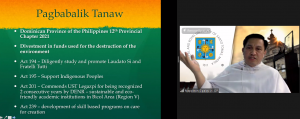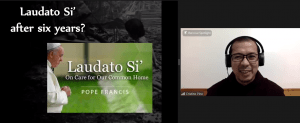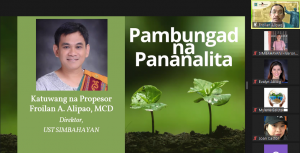The University of Santo Tomas SIMBAHAYAN Community Development Office, together with the Office of the Vice-Rector for Religious Affairs (OVRRA), and other offices, organized a webinar to commemorate the Season of Creation.
The Season of Creation (Panahon ng Paglikha) is a period of rejuvenating the correlation with the Creator and the creation through celebration, self-transformation, and collective commitment.



This is the time to reflect on our vocations as children of God and stewards of creation. It is supported by major religions, organizations together with the World Council of Churches, Christian Aid, and Lutheran World Federation, Anglican Communion Environmental Network, the Laudato Si’ Movement, and the Vatican Dicastery for the Promotion of Integral Human Development.
UST SIMBAHAYAN Director Asst. Prof. Froilan A. Alipao explained this year’s theme, “A Hope for All, Renewing the Oikos of God,” in his welcome remarks.
“Oikos in Greek means, family and home. With this, it is indispensable and inseparable to view nature as our home,” he said.
Inter-Congregational Theological Center Executive Director Rev. Fr. Cristino R. Pine, OFM, gave a retrospect of Laudato Si’. Six months after its publication, it has already been influential in the 21st Conference of the Parties (COP 21) in Paris, France.
Through the Paris Agreement, world leaders agreed to set an ambitious goal of limiting global warming to below 2, preferably to 1.5, degrees Celsius, compared to its pre-industrial levels.
The Intergovernmental Panel on Climate Change (IPCC) was mandated to release its special report in October 2018. Based on the IPCC Report, if the Paris Agreement goal will not be met in 2030, it can cause irreversible damage to the Earth. Fr. Pine also highlighted that the Laudato Si’ goes hand in hand with the United Nations 17 Sustainable Development Goals.
Continuing the discussion, UST Central Seminary Vice Rector Rev. Fr. Napoleon B. Sipalay, O.P., discussed the efforts of the Dominicans in promoting Laudato Si’. He presented the results of the survey on the Climate Change and Environmental Awareness conducted in Dominican schools and institutions in the Philippines, the Bien Hoa 2019 General Chapter, the Dominican Province of the Philippines’ 12th Provincial Chapter 2021, the Family Committee on Environment, and the challenges faced by the Dominicans.
The second part of the webinar was the call for environmental actions. SIMBAHAYAN Assistant Director Asst. Prof. Evalyn B. Abiog, Ph.D., urged the participants to partake in the Ambag sa Kalikasan activity of the UST SIMBAHAYAN.
With the Earth’s current situation, pollution is rampant and as such, everyone should take a stand and make even the smallest contribution to help the Earth to recuperate. Another way of moving toward a sustainable environment is to support the Save Zambales Kalikasan Movement.
Mr. Ricky Pabilonia, explained that Barangay La Paz, in San Narciso, Zambales and other towns in Zambales are currently under threat because of illegal dredging and black sand mining. Participants were encouraged to join in the advocacy by signing an online petition to stop the illegal activities.
A synthesis was delivered by Sister Teresa Dagdag, MM, of the DFJPCCP-Environment Committee. She emphasized the importance of ecological conversion, or a change of ecological issues, and that change should come from the heart. Rev. Fr. Victor Calvo, O.P., the Justice, Peace, and Care for Creation Promoter of Dominican Province of the Philippines, Inc., delivered the closing remarks.
The event, co-organized with the AlerTomas Cluster, Dominican Family for Justice, Peace, and Care for Creation-Philippines (DFJPCCP), Fellowship for the Care of Creation Association Incorporated (FCCAI) and Philippine Misereor Partnership Incorporated (PMPI), was moderated by Mr. Adrian Romero. It had close to 200 Thomasian administrators, faculty members, support staff, students, alumni, Dominicans, and guests from partner communities and institutions as participants.




